“The Seafire, certainly aesthetically the most elegant fighter ever to grace a carrier deck, was the product of adversity; it might be said to have been born of desperation.”
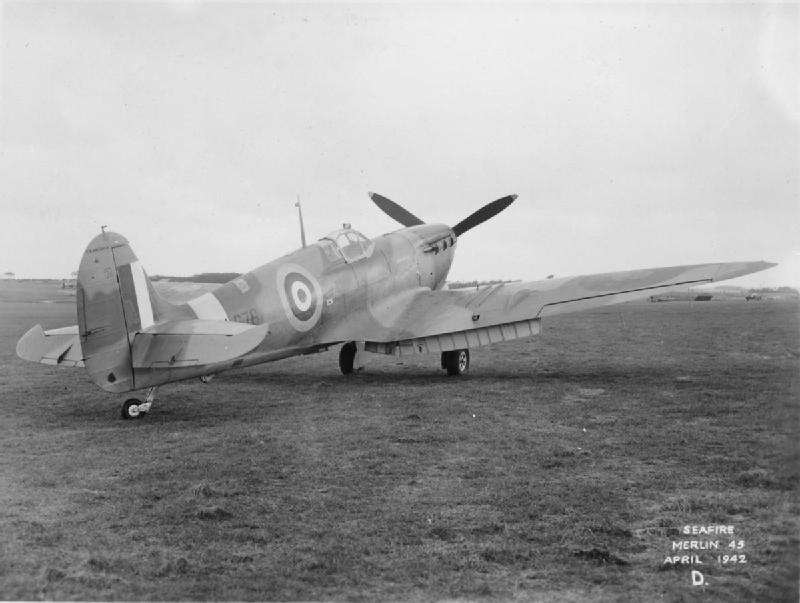
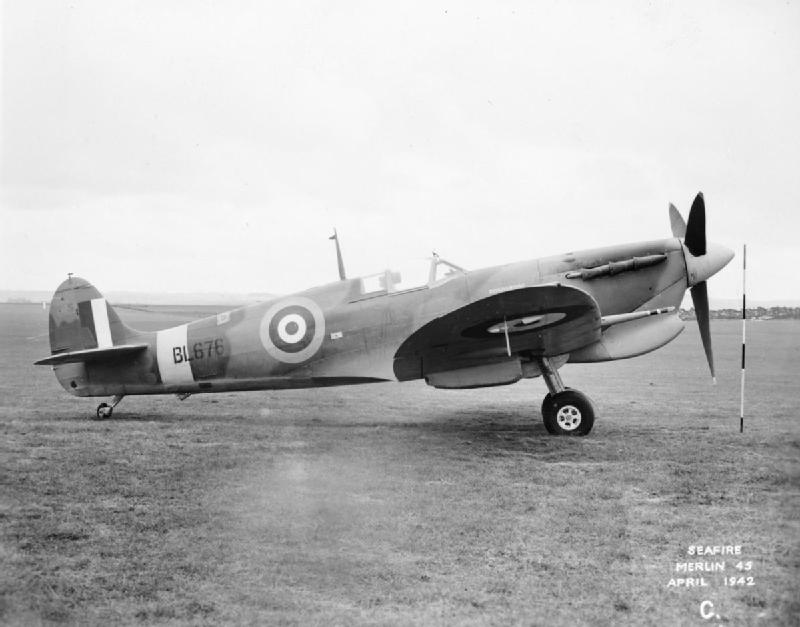
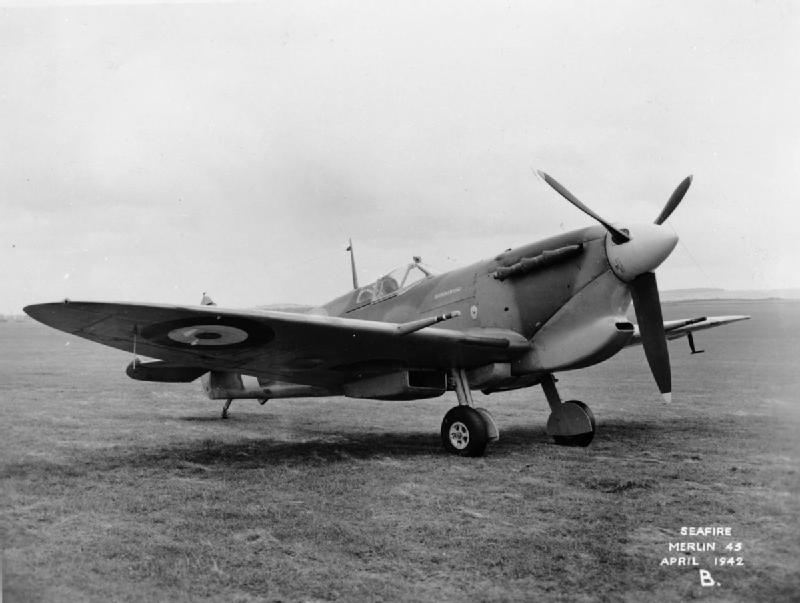
Origins
The Flee Air Arm’s role in the early war years was primarily a defensive one. Apart from a few notable exceptions, the carriers were mostly deployed on fleet and convoy escort duties.
This required anti-submarine and anti-surface reconnaissance patrols – and interception of inbound land-based bomber forces.
Hindering pilots every step of the way was the Royal Navy’s 1930s flirtation with the idea of abandoning carrier-borne fighters altogether. The almost ridiculous expectation that the Skua dive-bomber could also perform as a fighter was recognised as a failure during early testing of the type in the late 1930s.
An emergency fighter program was initiated: The specifications were for a two-seat heavy fighter intended to fill the role of escort and reconnaissance fighter.
It was not expected to tangle with superior single-seat land-based aircraft.
Nevertheless, the resulting Fulmar immediately found itself pressed into just such service as an interceptor to protect shipping in the close waters of the Mediterranean.
It proved to be adequate for the task, but development limitations imposed by the rushed nature of the Fulmar program meant it would rapidly become outclassed.
In this light of this expectation, the concept of a “Sea Spitfire” emerged almost as soon as the famous fighter began to demonstrate its scintillating performance in RAF hands.
Admiralty interest in a folding-wing version of the interceptor is evident in talks with manufacturers as early as November 1939.
The concept was raised in government circles in January 1940. Here the Admiralty declared it wanted a high performance interceptor ready for service within nine months.
Prime Minister Winston Churchill disagreed. He could see no reason to divert production of such a valuable fighter towards naval use.
He ordered the program be cancelled in March 1940.
"PRESENTING SEAFIRES". On the deck of the Carrier "Indomitable" the new Seafires - ocean going answer to the Spitfires - are now available for combat.
A line-up of Fleet Air Arm aircraft at RNAS Mill Meece / HMS Fledgling in 1943/44. The facility was used to train WRNS Air Mechanics (Ordnance) on FAA types: Shown here is a Seafire MkI, front, and a Corsair with a Martlet in the middle ground. Off the track to the right are two Fairy Barracudas. Facing the camera at the top of the image is probably a Sea Hurricane though it may be a Fulmar.
The weaknesses of the Skua, Roc and Sea Gladiator FAA fighters were exposed only a month later during the failed defence of Norway. At the same time, the landing of several un-hooked RAF Hurricanes aboard HMS Glorious during the evacuation of the Expeditionary Force exploded any myths about the ability of modern single-seat aircraft to operate from fleet carriers.
The US built Martlet was also proving to have limited potential. The aircraft diverted after the fall of France and Greece were unsuitable for carrier use. The non-folding wing fighters were also deemed not ready for combat as they did not have self-sealing fuel tanks and adequate pilot armour.
The non-folding Sea Hurricane was born of dire need and compromise. The conversion program was allowed to go ahead because the RAF regarded Hurricanes as inferior to the Spitfire, which remained the priority aircraft for homeland defence. The RN would be given used machines, anyway.
By late 1941, the dire need for a fast, single-seat carrier-borne fighter could be ignored no longer. The Admiralty again pleaded for a Sea Spitfire.
This time it received reluctant support from the Air Ministry. Several obsolescent Spitfire Mk IA machines were loaned to the Royal Navy for adaptability testing.
Test pilot Captain Eric 'Winkle' Brown had this to say about news of the “Sea Spitfire” program:
“This scheme was received with mixed feelings by those naval pilots in the know. Everyone admired the Spitfire and itched to fly it - but from an aircraft carrier? That was a horse of a very different colour! None needed convincing of the performance or handling attributes of this magnificent fighter, which was, surely, one of the greatest warplanes ever conceived, but there was a certain air of fragility about the aeroplane; a ballerina-like delicacy that seemed inconsistent with the demanding, muscle-taxing scenario of shipboard operations.”
FAA Pilot Hugh Popham's view:
From "Sea Flight: The Wartime Memoirs of a Fleet Air Arm Pilot"
The Hurricane was a good aeroplane, on land, on a deck or in the air. The Spit was adequate on a runway, bad, as it turned out, on a deck, but in the air one of the most exquisite machines ever made by man. It was beautiful to look at with that knife-fine wing-section and the two sheer ellipses of its leading and trailing edges, and with that flowing line from spinner to fin. And it was beautiful to fly, light and quick on the controls, without vices. It was always said that Mitchell’s wife designed the lay-out of the cockpit; whether it was true or not, it was a pretty compliment, for it was as neat as a new kitchen. Against its incomparable virtues could be set its silly little undercarriage, which was quite inadequate against the rough and tumble of deck-landing, and the long, long nose which stretched away in front of the pilot ad made him practically blind in the traditional, nose-up, deck-landing attitude. In so far as it had never been designed for a deck, it was unfair to charge the designer with these disadvantages: they were the outcome of a makeshift policy towards Fleet Air Arm aircraft which threw us on to the doubtful mercies of obsolescent R.A.F. machines, hastily modified, or on to the Americans.
“It was inevitable that the FAA had to have the Seafire. It was the only fighter available that would fit into the new, low-hangar-roofed Implacable and Indefatigable. There were no other British aircraft. Hawker’s Hurricane replacement — the Typhoon — was too large, the Martin-Baker MB5 was not being built and the Blackburn Firebrand had yet to fly properly. The Hurricane itself was not available in sufficient quantity and it was unlikely to be fitted with the Griffon engine or be modified to allow wing folding. Nevertheless, we had heard much about the beautiful Spitfire and we looked forward to our new task
”
Air Ministry and RAF support was slow and reluctant. Only half the numbers of Spitfire airframes requested for conversion were delivered.
It was not until December 9, 1941, that the Defence Supply Committee finally responded to the FAA’s plight. It ordered all the Royal Navy’s fighter and bomber aircraft needs be met – including production of Seafires .
Once again, the Air Ministry prevaricated. Delivery of Seafires was slow, and development of the vital folding wings delayed.
By late 1942 the need for a competent fleet fighter became paramount: The Admiralty stated its need for 65 Spitfires for conversion to Seafire status to enable air cover for a proposed amphibious landing on the Italian mainland – at Salerno. This was soon boosted by an order for a further 48 machines. Delivery was stipulated as being necessary before September 1943.
The Ministry of Aircraft Production granted the RN 114 Seafires, of which 66 were to be delivered to the FAA in early 1943.
A review was conducted in February 1943 to determine the FAA’s ongoing aircraft needs. Demand for single-seat fighters was at an all-time high. US supplied aircraft could not be relied upon: The USN was itself struggling at the time to meet the demands of re-equipping its own carriers.
The Seafire was determined to be the best available fighter – despite its well established problems. The prototype Firebrand was deemed too large and underpowered, while the Firefly was behind schedule and showing more promise as an attack aircraft than an interceptor.
“I had heard that the Seafire, like the Spitfire was a delight to fly. I would have to get used to the much lighter stick forces. I soon found out its other characteristics. Its thin wings and smaller frontal area increased its level speed over that of the Hurricane by 30 knots IAS at all heights, at identical power settings. In the dive, whereas the Hurricane more or less stopped at 330 knots, the Seafire got faster and faster until it had some 380 knots on the clock.”
Development
When the conversion of Spifires into their new naval role finally swung into action, the dominant airframe in production for the RAF was the Spitfire Mk V. Naturally, this variant would become the basis of trials.
The only major change over the basic RAF Spitfire Mk V machine was the installation of a retractable “V”-frame containing an arrester hook to the strengthened underbelly of the fighter. The final flight-deck modification was catapult spools to allow the Seafire to be mounted on a carrier’s accelerator for an assisted take-off.
FAA pilot Henry "Hank" Adlam's view:
From "On and Off the Flight Deck: Reflections of a Naval Fighter Pilot in World War II"
The Seafire, which was a normal Spitfire with the attachment of a hook for deck-landing, was in reality entirely unsuitable for Carrier operations. The narrow track of the undercarriage, its fragility and that of the whole fuselage made the Seafire unable to cope with the constant stresses of Carrier landings. The big wooden propeller constantly shattered because it had too little deck clearance. The aircraft had a very limited range, no bomb load and, with the extra weigh of the hook, was not all that much faster than the Wildcat and with lesser fire-power. The in-line engine, with the scoop-type coolers under the wings, made a successful ‘ditching’ in the sea difficult. But also, although a beautiful machine just to fly, it was very difficult to deck-land because of its tendency to ‘float’ over the wires when the engine was cut. Over the years, in the process of operating from Carriers, the Seafire seriously hurt or killed many pilots. Yet there were a few pilots of above average ability who loved the thing, despite its many faults as a Carrier aircraft.
As with the RAF fighter, the original Seafires had no provision to carry bombs. Nor had the folding wings necessary for extensive naval use been approved.
Other changes included a strengthened slinging point being introduced behind the canopy for when the aircraft had to be winched aboard. A naval high frequency radio, Identification Friend or Foe transmitter, a homing beacon and a standard naval radio were also fitted.
The total weight penalty over the Spitifire VC was about five per cent, and top-speed fell by about 5mph.
FAA pilot Henry "Hank" Adlam. The Disastrous Fall and `Triumphant Rise of the Fleet Air Arm from 1912 to 1945
The Seafire was so basically and obviously wrong as a fighter aircraft for Carrier operations that I have always been puzzled to understand how it could ever have been assessed as acceptable by the Navy Trials pilot and the Trials Unit.
Particularly have I been puzzled because I believe that the Trials pilot was none other than the then Lieutenant Eric (Winkle) Brown, DSC, RNVR, who became one of the best test pilots in the world, if not arguably the best. But that point is for a later paragraph. I can only conclude meantime that there were some factors that influenced the assessment of the Seafire as acceptable for squadron work in a Carrier. In the case of the Seafire, the Trials pilot was given an aeroplane based on the Spitfire, an already famous fighting machine, and his task first of all was to find out whether it could be deck landed at all, always a hazardous undertaking. If and when he succeeds in deck landing it, he must assess how difficult it was to do so and be able to describe such difficulties as he found and give his recommendations on how to overcome them. For example, what method and speed of final approach does he recommend is best for the landing. I believe that the Trials pilot advised to crab the Seafire on a straight approach to the deck with the nose pointing slightly to starboard of the line of approach to give a better view of the deck. My method and that of many other pilots , particularly for the Corsair, was on the contrary to keep the long nose of the aircraft out of my line of sight by landing off quite a steep turn. But who am I to argue the case with one of the truly great pilots ever known? The next difficulty is that the Trials pilot must try to judge from his previous experience of flying in company with other pilots in an operational environment whether the aircraft is suitable and reasonably safe to be deck landed continuously by an ‘ average’ squadron pilot. Here is where Lieutenant Brown, assuming he was the Trials pilot, might possibly have made a misjudgement. First because he himself was an astoundingly good pilot and thus he might not have appreciated just how very difficult deck landing was for an ‘average’ pilot. Further to this point, it is significant that fellow pilots in his last squadron, before he transferred to Trials flying, were nearly all experienced and certainly not average. But the most likely factor of all is that the Board of Admiralty were putting almighty pressure on the Trials Unit to accept the Seafire.
The first carrier trials were conducted by RN Fighter School commanding officer Lieutenant Commander H. P. Bramwell aboard HMS Illustrious in late 1941.
Test conditions were not ideal: HMS Illustrious had suffered bow and flight deck damage in a collision with HMS Formidable as the pair had returned from the United States following extensive battle-damage repair work.
His report had immediate implications for the future of the Seafire program: The long nose of the nimble fighter had forced him to use an “unorthodox” landing approach technique which would allow him to see the flight deck until the very last moment. He also warned the undercarriage was delicate and not up to the heavy deck landings FAA pilots often found necessary.
Nevertheless, his summary was positive enough for development of the Seafire to go ahead.
The first navalised conversion – of a Spifire VB – was completed in January 1942. This Seafire Ib was delivered to the RN for operational service on June 15.
More flight-deck trials were conducted aboard the highly experienced HMS Victorious in March and April 1942. The first Seafire IIC also was tested aboard HMS Illustrious in March.
Again, the lack of vision over the Merlin was the main complaint from the aircraft tested on Victorious. The Seafire IIC testing, however, raised additional concerns. An inspection of the aircraft after a series of accelerator launches revealed bucking in the rear fuselage and tail unit. The tail plane had become deformed, and the Merlin displayed a startling tendency to cut-out on launch.
Remedial work was immediately commenced. A Supermarine report from November 1942 reveals efforts to strengthen the airframe by up to 50 per cent.
A full year after the original trials aboard HMS Illustrious ( September 1942), test pilot (then) Lieutenant E. Brown experimented with the Seafire’s ability to land on the small escort carrier HMS Biter.
Needless to say, the 430ft flight deck – as opposed to HMS Illustrious’ 730ft – proved to be a serious challenge.
Lieutenant Brown would report:
“I picked her up and started to think about my approach. I flew round the ship, turned on to my approach path, and came in. As I closed the stern I swung the nose to starboard with the rudder and counteracted the swing by putting on slight opposite bank. In this way I made the Seafire crab in sideways, so that I had a view of the deck over the leading-edge of the wing. I sank lower towards the stern. I was over the round-down at a speed very close to the stall. Quickly I took off the bank and kicked off the rudder as she sank on the deck. She made a good three-point touchdown and caught a wire”.
“We pushed the Seafire to its limit, which was the amount of stress the frail undercarriage would take. The Martlet’s sea legs were far stronger and more resilient than the Seafire’s. If the Seafire was landed on its main wheels instead of being three-pointed, it would bounce like a spring lamb, whereas the Martlet’s bandy legs would just give a bit more at the joints and harmlessly absorb the heavy shock. This was an important characteristic because landing bounce meant missed wires and a ticket into the crash barrier.”
Test pilot 'WInkle' Brown had not noticed that the little escort carrier had been off the wind, without a batsman, with the arrester-wires lowered and flying the “G” (go home, abort mission) flag.
It was a perfect landing by an expert pilot.
His second attempt – this time with HMS Biter ready to receive its guest – ended up with the arrester-hook being torn off and the Seafire crumpled into the little box-island bridge.
Such scenes were to become disturbingly common, no more so than during the vital carrier-based Operation Avalanche, the invasion of Salerno.
Captain Brown remarked:
“The Avalance operation had undoubtedly tarnished the Seafire’s reputation and the attrition that it had suffered was totally unacceptable. Although we believed that we had resolved the hardware problems reasonably satisfactorily, the Fifth Sea Lord, Rear-Admiral D W Boyd, now wanted to know something of the pilot problems associated with the Seafire.”
FAA pilot Henry "Hank" Adlam's view:
From "On and Off the Flight Deck: Reflections of a Naval Fighter Pilot in World War II"
For the Seafire to land on the small deck of an Escort Carrier, even under ideal conditions, calls for considerable skill and experience on the part of the pilot. But at Salerno, the wind conditions were no better than a zephyr breeze and almost a dead calm, conditions entirely to have been expected for that time of year. Thus the Seafires had to operate with a total wind speed over the deck of only sixteen knots, being the maximum speed of the Escort Carriers, whereas they needed a total wind speed over the deck of at least twenty-eight knots. These were desperately difficult landing conditions for the Seafire pilots; conditions which surely should have been anticipated at the outset when the whole Salerno operation was being planned by Rear Admiral Vian who, despite never having flown an aircraft or having served on an aircraft carrier, had been put in charge of this, the first multi Carrier Fleet of the Royal Navy… Even with hindsight it is difficult to see how or why the Admiralty came to rely upon Seafires for this particular task. Either a deliberate gamble was taken that there would be adequate wind conditions or, more likely is my guess, Admiral Vian, in charge of the Salerno show, simply had no experience of naval aviation to make the right decisions.




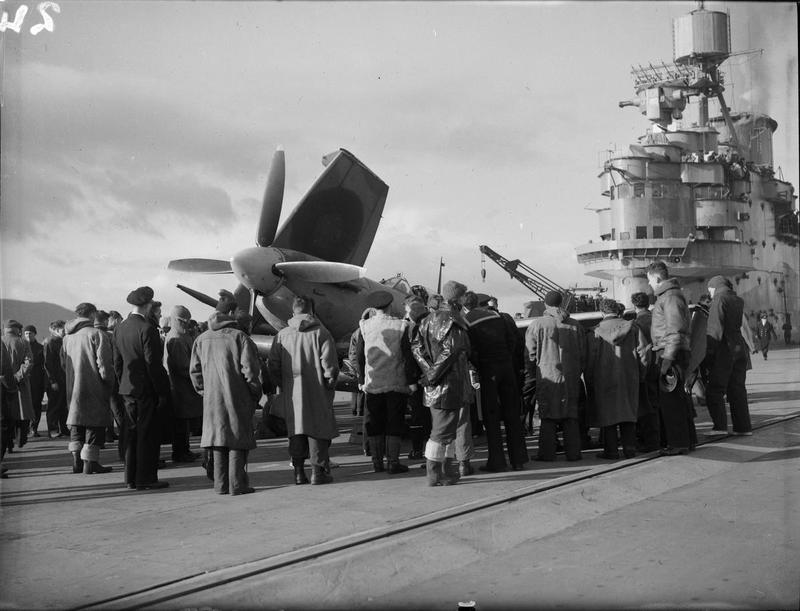
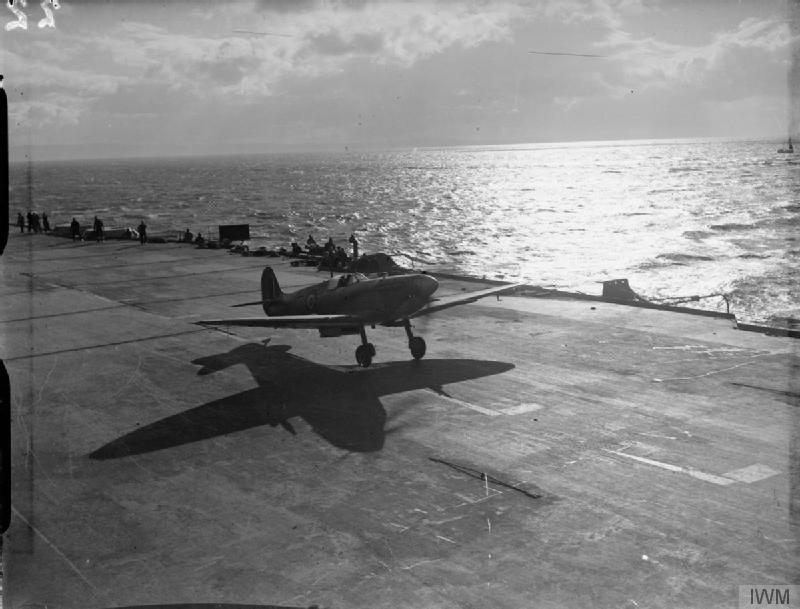

Above: Seafire III trials aboard HMS Illustrious on the Clyde between 8 and 9 February, 1943.
The pilot chosen to compile the new report was the most experience Spitfire pilot in Britain, Jeffrey Quill. He replaced Captain Brown who was regarded as being too experienced at – and too enthusiastic about - the Seafire. Quill submitted his report in February 1944:
Pilots had to be trained in a curved approach to the deck
Multi-ejector exhaust manifolds were to be fitted to allow pilots to land with their heads out of the cockpit and looking alongside the portside engine cowling
The Seafire displayed inherent poor speed control that would only take practice to cope with
The Seafire was not robust enough for carrier landings, but a sting-style hook would likely reduce accident rates.
Personal account, Mike Davey, FAA Seafire pilot
The problems with the Seafire, were a weak and narrow undercarriage and, because of a long nose, the forward vision was very restricted, and if flown at only a few knots above stalling speed one could easily miss the wires and end up in the barrier. During the Battle of Britain, Lord Dowding said 'we shall have enough Spitfires if our young pilots learn to land them safely'. However practice makes perfect and by the end of our sojourn in the Pacific our prang rate had been greatly reduced. Having criticised the Seafire it should also be said that when in the air it was the most beautiful aeroplane ever made and had absolutely no vices.
Captain Brown was not unfamiliar with the Seafire’s failings, but he remained convinced of its potential:
“The sour reputation that the Seafire was acquiring was in no way relieved by common knowledge of the sturdiness, better endurance and markedly superior deck-landing and ditching qualities offered by the new Grumman Hellcat. Furthermore, the less tractable side of the Seafire’s nature was prone to exaggeration and the result was that many pilots were unduly apprehensive of deck-landing this fighter.”
A crashed Seafire aboard HMS INDEFATIGABLE. A large chunk of its wing can be seen to have been carried away by gunfire. The presence of the SEAC roundel on the right wing simply represents the use of a spare wing component not painted for the Pacific theatre.
“And finally, although undoubtedly a lovely little machine to fly and to operate from an airfield, it was devilishly difficult to land on to a flight deck. The pilot, low down in the cramped little cockpit, had difficulty in seeing the deck over the long nose, which blocked his view. Its beauty as a flying machine was its own undoing when it came to a landing on the small deck space. This was because, instead of clonking down nice and firmly as the pilot closed the throttle to stall it on to the deck, the machine tended to keep floating and flying all too frequently straight into the barrier. Worse still it was known to bounce on touchdown and float over the barrier on to the people and other aircraft in the deckpark on the other side with catastrophic results. Notwithstanding all that, I have to admit that some above-average pilots loved the Seafire , but very few pilots, even of that higher ability, were able to deck land it continuously without eventually doing it some damage.”
A successful "belly landing" by a British Pacific Fleet Supermarine Seafire, whose undercarriage was damaged during on operation against the Japanese. Photograph possibly taken on board HMS INDEFATIGABLE. Note the arrester wires lying across the deck.
Controversy
The numerous photographs of “pranged” Seafires suggests such accidents were extremely common. This is not an entirely fair impression.
The aircraft carrier flight-deck is a much more restrained and controlled space. Photographers had the opportunity of taking close-up and “dirty” pictures from the close – but safe – proximity of the ship’s island.
FAA photographers were often tasked with photographing every landing for review and analysis purposes. Naturally, the most dramatic pictures gained the widest circulation.
The Spitfire itself had more than its fair share of “prangs”. But these also would happen regularly on the broad expanse of grass field. Here, the opportunity for embarrassing “snaps” was greatly reduced.
But it was a real problem for the land-based interceptor: Lord Dowding said during the Battle of Britain: 'We shall have enough Spitfires if our young pilots learn to land them safely'.
Many 'prang' photographs also do not explain that the crashing aircraft was actually battle-damaged.
By the end of hostilities, Seafires of all marks and in all theatres of World War II had claimed a total of 39 kills.
This low figure is more a reflection of the mission of the FAA than it is of any performance issues on the Seafire’s behalf.
The interceptor was tasked with protecting the fleet by disrupting and driving-off enemy attack runs. This was achieved off Sakishima and Salerno. Estimates place 30 per cent of all enemy raids being turned away by Seafire patrols before reaching fleet defensive screens.
Kills were a secondary – if desirable – outcome.
Cunliff-Owen Seafire production facility at Southampton.
“I have to make my apology to the Seafire for, in the final stage of war in the Pacific, the aircraft did very well indeed as a Carrier-borne fighter. This was largely due to the initiative of a squadron commander who adapted an American long-range fuel tank to fit under the fuselage of the Seafire, thus improving the range and the consequent value of the aircraft considerably. But most pilots still found it to be a swine to deck-land.”
Unissued / Unused Material Shots aboard a British aircraft carrier (light conditions dull) showing Seafire and FireFly planes operating aboard HMS Implacable while in the British Pacific Fleet,
FAA pilot Henry "Hank" Adlam, whose very skeptical opinions of the Seafire are repeatedly quoted above, finally got to fly the machine shortly after the War:
From "On and Off the Flight Deck: Reflections of a Naval Fighter Pilot in World War II"
The following morning was time for me to fly the dreadful Seafire...
... for as such I had always regarded it, knowing so well the number of young pilots it had killed while being deck-landed.
I didn’t dread flying the thing; if other people could fly it then I most certainly could; I just didn’t look forward with pleasure to the experience.
I had been allocated a Seafire XV with a more powerful engine than the earlier models and assumed that it would have considerable engine and propeller torque which might give it a tendency to swerve badly on take-off.
In preparation for the flight, I spent some time in the cockpit to learn the haphazard layout typical of a British designed fighter, so different from the orderly arrangement of an American cockpit. I didn’t like the Seafire and I was prepared to damn it even before I had started the flight.
Well, I flew the damn thing and found that it was a beautiful machine to fly.
An absolute thoroughbred of an aircraft requiring only the most delicate pressures on the controls for it to respond immediately and perfectly.
I went through my usual procedure at height with an aircraft new to me and could find nothing to fear from its performance. I followed that up with some aerobatics to which the Seafire responded beautifully enough to flatter my dubious ability as an aerobatic pilot. Now, back to the aerodrome for the landing and let’s see, I thought, if I can find what it is that has caused so much difficulty and so many deaths in landing it on a deck. But on a runway with plenty of space, I found that the Seafire was the simplest of aircraft to land…
I found time to dummy deck-land the Seafire. The first attempt was abortive. Although apparently fully stalled when I thumped it down at very slow speed on the selected spot of the runway, the wretched thing still contrived to balloon upwards and would have put me into the barrier had there been one. After that I learned the trick of timing the closure of the throttle earlier, while holding the stall attitude, so that it came down a second or so later and stayed down on the spot.
When the final Seafire variant was retired in November 1954 , test pilot Captain 'Winkle' Brown was not afraid to express his remorse.
“The Seafire had seen more than eight years of first-line service and the number of combat sorties that it flew in that time must surely have approached five figures. For my own part, I regretted its passing as, for me, it marked the end of an era... It was an aeroplane which seemed tailormade for the pilot and I cannot imagine any other aircraft that would have permitted the liberty of the crab-type approach that I and may other pilots used for deck landing. True, it left much to be desired with regard to robustness, particularly in its early versions, but then it was doing something that it was never meant for in the first place.”


















